Argentina
Template:Infobox State/Maintenance/NAME-German
Argentina (Spanish![]() [aɾxenˈtina]) is a republic in southern South America. It borders Chile to the west, Bolivia and Paraguay to the north, Brazil and Uruguay to the northeast, and is bounded by the Atlantic Ocean to the east.
[aɾxenˈtina]) is a republic in southern South America. It borders Chile to the west, Bolivia and Paraguay to the north, Brazil and Uruguay to the northeast, and is bounded by the Atlantic Ocean to the east.
The country's name is derived from the Latin name for silver - argentum - and dates back to the Spanish colonial period, when precious metals were hoped to be found here. It was part of the Spanish colonial empire until its independence in 1816. Politically, Argentina is a presidential federal republic in which the individual provinces have far-reaching powers. According to the Argentine constitution, the official names of Argentina are República Argentina, Provincias Unidas del Río de la Plata and Confederación Argentina.
With an area of almost 2.8 million km², Argentina is the eighth largest country in the world and the second largest in South America and the fourth largest in the Americas. Due to its large north-south extension, the country has a share in several climate and vegetation zones. In terms of population, it ranks third in South America (after Brazil and Colombia) and fifth in the Americas, with about 45 million inhabitants. About one third of the population is concentrated in the metropolitan area of the capital Buenos Aires, which is considered to be an important cultural center of the Americas, where, among other things, the Tango Argentino has its origins. The cities of Córdoba, Rosario, Mar del Plata and Mendoza are further urban centers. Large parts of the dry and cold south, on the other hand, are only very sparsely populated.
Until about 1950, Argentina was one of the richest countries in the world. Traditionally, agriculture, cattle breeding and the extraction of raw materials played a major role in the economy, although today the service sector accounts for the largest share of GDP at around 60 %.
Politically, the country was strongly influenced by immigration from Europe, especially from Italy and Spain, until the mid-20th century. The most important political stages since then have been Peronism (1946-1955; 1973-1976), several military dictatorships (esp. 1976-1983), redemocratization (after 1983), and neoliberalism (1990s) until the 2001 Argentine crisis and subsequent consolidation.
Geography
→ Main article: Geography of Argentina
Argentina has an area of 2.78 million km², making it the second largest country in South America after Brazil. The extension from north to south is 3694 km, that from west to east at the widest point about 1423 km. It borders the Atlantic Ocean to the east, Bolivia and Paraguay to the north, and Brazil and Uruguay to the northeast; their longest common border is formed by Chile and Argentina in the west of the country.
| Border with | Length |
| Bolivia | 742 km |
| Brazil | 1132 km |
| Chile | 5308 km |
| Paraguay | 1699 km |
| Uruguay | 495 km |
| in total* | 25,728 km |
| * including coastline | |
The entire western border region is occupied by the Andes, the longest continental mountain range on earth. The central north of Argentina is occupied by the Gran Chaco, a hot dry savannah. To the east of this, along the Río Paraná, is the hilly country of the province of Misiones. There, at the border triangle Argentina-Paraguay-Brazil, are the Iguazú Falls; they are about 2.7 kilometres wide and are among the largest in the world. South of it, between the big rivers Río Paraná and Río Uruguay, lies the humid and swampy Mesopotamia. On the Río de la Plata, the common estuary of these two rivers, lie the city of Buenos Aires and the province of the same name, Buenos Aires, the economic heart of Argentina, where about a third of the country's inhabitants live.
West and south of Buenos Aires are the pampas, a grassy plain where most of the country's agricultural products are produced. This region is home to large wheat fields and pastures for cattle; beef exports plummeted from 771,000 tons to 190,000 tons starting in 2005 as a result of government export restrictions and bans. In 2017, 308,638 tons of beef were exported again.
Between the Pampas and the Andes lie the mountain ranges of the Sierras Pampeanas in central Argentina. These low mountain ranges reach heights of 2800 m in the Sierras de Córdoba and up to 6250 m in the Sierra de Famatina in La Rioja. Patagonia, located in the south of Argentina, is characterized by strong westerly winds and has a very harsh climate. This area, which makes up about a quarter of the country, is very sparsely populated. The lowest point of the country and of the whole of America is the Laguna del Carbón, 105 m below sea level. It is located between Puerto San Julián and Comandante Luis Piedra Buena in the province of Santa Cruz.
A section of about 60 km of the border with Chile, located in the Southern Patagonian Ice Field, is not marked as a clearly drawn border, but is occupied by a special zone agreed between the two countries.
Argentina claims a sector of the Antarctic continent, but this claim conflicts with the Antarctic Treaty, which has been in force since 1961.
Mountains and hills
In the Argentine Andes there are many mountains over 6000 m high. Among them are the highest mountain of the American continent, the Aconcagua with 6961 m height and the two highest volcanoes of the earth, the Ojos del Salado with 6880 m and the Monte Pissis with 6795 m. In the southern Andes, the mountains are less high; many are always covered with snow because of the cold and humid climate. The Sierras Pampeanas also have some very high altitudes: Sierra de Famatina in the province of La Rioja also reaches over 6000 m. However, the heights of this mountain complex drop towards the east, and in the Sierras de Córdoba only a maximum of 2800 metres is reached.
The northern Patagonides (Mesetas Patagoniens) still show 4700 m height in the southeast of Mendoza, their height decreases towards the southeast. In the other areas of Argentina the mountains reach only in exceptional cases over 1000 m height. These include the Sierras Australes Bonaerenses (Sierra de la Ventana and Sierra de Tandil) on the Atlantic coast and the hills and mountains of Misiones.
Rivers and lakes
Argentina's hydrology is dominated by the tributaries of the Río de la Plata. Its catchment area covers about 5,200,000 km². About one third of this lies in Argentina, the rest in Bolivia, Brazil, Paraguay and Uruguay. Tributaries of the Río de la Plata are the Río Paraná and the Río Uruguay. In the north at the border to Brazil is the Iguazú National Park. In it the river Iguazú with the Iguazú waterfalls, which are three times as large as the Niagara Falls. The second largest catchment area is the Río Colorado in northern Patagonia, whose largest tributary, the Río Salado del Oeste, drains a large part of western Argentina, although much of its water volume evaporates on the way or seeps into swamps because of the dry climate.
Argentina has two major lake regions. The most extensive is at the foot of the Southern Andes, where a long chain of meltwater lakes stretches from Neuquén Province to Tierra del Fuego. In addition, the western central Pampas and the southern Chaco contain numerous lowland lakes, some of which are only a few meters deep and often saline. The lowland lake Mar Chiquita with 5770 km² in the province of Córdoba as well as the Andean lakes Lago Argentino (1415 km²) and Lago Viedma (1088 km²) are located in the National Park Los Glaciares, which was declared a UNESCO World Heritage Site. The Perito Moreno glacier is also located there.
Islands
Argentina has only a few islands despite its long coastline. The largest is Isla Grande de Tierra del Fuego, part of the Tierra del Fuego archipelago, with 47,020 km², shared between Argentina (Tierra del Fuego Province, 21,571 km²) and Chile (25,429 km²). The only other island area of significance is the south of Buenos Aires Province, where two extensive tidal flats are found in the bays of Bahía Blanca and Bahía Anegada. The islands there are flat and, with the exception of Isla Jabalí, where the seaside resort of San Blas is located, uninhabited. The largest island is Isla Trinidad with 207 km². Furthermore, there are some smaller rocky islands off the Patagonian coast.
The Falkland Islands (also Malvinas, English Falkland Islands, Spanish Islas Malvinas), a group of islands in the southern Atlantic Ocean, are a disputed territory under international law. They belong geographically to South America, lie 600 to 800 km east of southern Argentina and Tierra del Fuego at 52° south and 59° west, and are British overseas territory. They have been claimed by Argentina since 1833. Argentina's occupation of the islands on 2 April 1982 triggered the Falklands War, which lasted until 14 June 1982 and ended in defeat for Argentina. The largest islands of the Falkland Islands are East Falkland (Soledad) with 6683 km² and West Falkland (Gran Malvina) with 5278 km². Under the same status is the southeast of the Falkland Islands located territory of South Georgia and the South Sandwich Islands.
Climate
| (For general explanations see: climate diagram) | |
Argentina has from tropical areas in the extreme northeast over subtropical in the rest of the north and an extensive temperate climate zone to cold climate regions in the south and in the Andes almost all climate zones combined in one country.
The northwest of Argentina is dry in the area of the Andes with a short rainy season in summer. In it you will find the high desert Puna, whose west is one of the areas with the least rainfall in the world, and the steppe-like, barren Monte at the foot of the Andes in the provinces of Mendoza, San Juan and La Rioja.
The eastern slopes of the foothills are home to subtropical cloud forests in the provinces of Tucumán, Salta and Jujuy, which have high precipitation in summer due to the rains of the humid easterly winds, but are relatively dry in winter. To the east, the Gran Chaco joins in the central north, its precipitation concentrated in summer; the same applies to the region of the Sierras Pampeanas in central Argentina. In both regions, precipitation decreases towards the west.
The northeast as well as the Pampas region are humid throughout the year, with the highest rainfall occurring in the subtropical rainforest of Misiones province.
The south (Patagonia) is in the west wind zone, which is why here the western part receives more precipitation than the east. The Andes are constantly humid and cool temperate in temperature. They act as a barrier to the humid Pacific winds, so that the Patagonian stratified plain that follows to the east is very dry and semi-desert. In this region, the climate is determined by the pampero wind that blows regularly every one or two weeks from the southwest. A special case is the climate in the southern part of Tierra del Fuego with its cool oceanic climate, where both Pacific and Atlantic influences determine the weather due to the absence of the Andean climate barrier. There, the precipitation amounts are relatively high and the temperatures show a relatively small deviation between summer and winter.
flora and fauna
According to the very different climatic zones of Argentina, the vegetation and wildlife also vary greatly. In total, about twelve percent of the land area is forested.
Flora
In the warm humid tropical and subtropical rainforests in the north, tropical plants thrive, such as rosewoods (Dalbergia), guaiac trees (Guaiacum officinale), rosewoods (Jacaranda mimosifolia) and quebracho trees (Schinopsis lorentzii), from which tannic acid is extracted, but also palms. The Gran Chaco, also in northern Argentina, has savanna-like vegetation dominated by algarrobo trees (mainly Prosopis alba and Prosopis nigra); quebracho also occurs. The south and east of the Chaco, with its milder climate, is intensively farmed, while the north is still largely pristine.
The Pampa is characterized by extensive grasslands with various grasses. Apart from eucalyptus (Eucalyptus), American plane trees (Platanus occidentalis) and acacias (Acacia), no trees are found here; the former two genera are not native. Due to the very fine stoneless soil, agricultural cultivation is well possible, so that little original vegetation has survived.
Patagonia is already in the shadow of the Andes and is a barren and largely treeless landscape. Here, as in the Pampas, grasses predominate, but the vegetation is adapted to the much drier conditions. In addition, one finds various herbaceous plants and shrubs. Because of the stony soil, cereal cultivation is not possible, instead the grasslands are used as sheep pasture.
In the foothills of the Andes and on Tierra del Fuego there are extensive coniferous forests with spruce (Picea), cypress (Cypressus), pine (Pinus), cedar (Cedrus) and other timber. Near the Chilean border there are isolated groups of false beech (Nothofagus). The tree line is at about 3500 m. In the dry northern highlands of the Andes, many cacti (Cactaceae) and briars are found in the arid semi-deserts.
The flower of the ceibo (cock's comb tree or coral tree) is one of the national symbols as a so-called "national flower".
Fauna
In the tropical north, the animal world is extremely diverse. Various species of monkeys, jaguars, pumas, ocelots, raccoons, coatis, anteaters, but also tapirs, umbilical pigs and reptiles such as snakes and caimans live here. Birdlife is home to hummingbirds, flamingos, toucans and parrots in the tropical north. Piranhas can be found in the rivers along with many other fish. In the pampas one finds armadillos, maned wolves, pampas foxes, pampas cats, pampas deer, nandus, various birds of prey such as falcons as well as herons. In the barren areas of the Andes you can meet the wild llamas, guanacos and vicuñas, as well as the Andean condor, which is one of the largest birds in the world. Predators are the mountain cat, the puma and the Andean jackal. Migratory birds such as flamingos are often found at salt lakes. In Patagonia and Tierra del Fuego, animal life is more sparse. Pumas, nandus and guanacos also live here; the Patagonian huemul and pudú (a small deer) are part of the fauna of the southern Andes. Cormorants and Magellanic woodpeckers also nest in Tierra del Fuego. The Patagonian coasts are home to Magellanic penguins and colonies of South American fur seals and maned seals. The coastal waters of Argentina are home to southern right whales, orcas and Commerson's dolphins, among others, as well as hake, sardines, mackerel and dorado.
See also: List of National Parks in Argentina
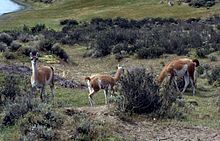
Guanacos - a wild form of the llama
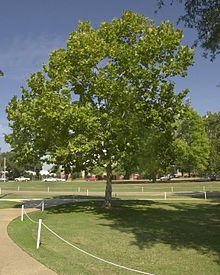
An American plane tree
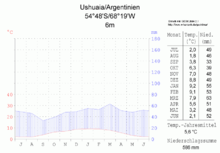
Climate diagram Ushuaia
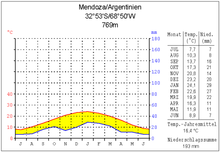
Climate diagram Mendoza
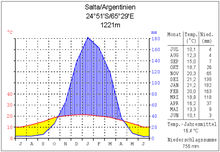
Climate diagram Salta
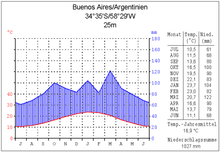
Climate diagram Buenos Aires
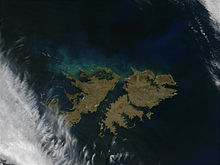
The Falkland Islands claimed by Argentina from space
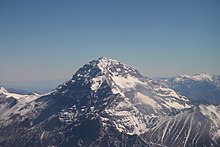
The Aconcagua

The Río de la Plata with the greater Buenos Aires area at the bottom right

Lago Argentino and Perito Moreno Glacier
Population
→ Main article: Population of Argentina
Argentina has a population of about 45 million inhabitants. This corresponds to a population density of 16.3 inhabitants/km². About 87% of the population lives in cities of more than 2000 inhabitants, of which 11.5 million alone are in the agglomeration of Gran Buenos Aires. This has a population density of 2989 inhabitants/km². The city and the entire province of Buenos Aires together have 16.6 million inhabitants, the provinces of Córdoba and Santa Fe about three million each, so that in these three provinces located in the central part of the country together live more than 60% of the population. Large parts of the rest of the country, on the other hand, are very sparsely populated, especially in the arid south, where only about one to three inhabitants/km² live.
Life expectancy from 2010 to 2015 was 76.0 years (women 79.8, men: 72.2).
Ethnic groups
According to official statistics, more than 90% of the population is descended from immigrant Europeans, of which 36% are Italian, 29% Spanish and 3-4% German. In the Buenos Aires area and in the provinces of Chaco and Misiones, Polish culture also plays a role. These are descendants of Polish emigrants from the 1920s. Until the early 1990s, it was assumed that the proportion of mestizos - descendants of both Europeans and Indians - was less than 10%. According to more recent findings, however, their proportion is far higher. A 2012 genetic study found 65% European, 31% Native American and 4% Black African heritage. This discrepancy is attributed to the fact that mestizos used to suffer from severe discrimination and therefore declared themselves "white". In Argentina, an estimated 300,000 people have Roma ancestry, many of whom have abandoned their own culture and assimilated due to discrimination and lack of cultural promotion.
Indigenous population
→ Main article: Indigenous peoples in Argentina
Only a minority of Argentines are exclusively descendants of the total of 30 ethnic groups that lived in the country's territory before the arrival of the Spanish. This is partly because Argentina was densely populated only in the northwest before the colonial period, and partly because the remaining indigenous peoples were largely exterminated by the Spanish and later by the Argentines. The National Institute of Indigenous Affairs (INAI) estimates the number of indigenous people at about 1 million, but indigenous organizations such as the AIRA (Asociación de Indígenas de la República Argentina) estimate it at more than 1.5 million.
In 2001, about 2.8% of all Argentine households had indigenous household members, although the proportion varied greatly from province to province. The province of Jujuy, for example, had the highest proportion at 10.5 %. The lowest proportion was in Corrientes province, at 1.0%. In the capital Buenos Aires it was 2.3%.
The largest groups are the Kollas in Jujuy and Salta, the Mapuche (Araucanians) in Neuquén and Río Negro, the Wichí and Toba in the Chaco and Formosa, and the Guaraní in the northern provinces. Only a minority of the indigenous people live in their ancestral settlements; many have moved to the large cities, where they often live in poor conditions as poorly paid workers. In Rosario and Resistencia, for example, there are districts inhabited only by Toba Indians, and the same is true of Kollas in San Salvador de Jujuy and San Miguel de Tucumán. Since the 1980s, there have been growing movements within these tribes to preserve and disseminate traditional culture, for example via radio stations and at schools.
Immigration and emigration
The number of foreigners in the 2010 census was 1,805,957 (4.6% of the population), with the largest groups being Paraguayans (550,713), Bolivians (345,272), Chileans (191,147), Peruvians (157,514) and Italians (147,499). The province of Santa Cruz (12%), the city of Buenos Aires and Tierra del Fuego (both 11%) have the highest percentage of foreign-born. In 2017, 4.9% of the population were migrants.
Historically, the largest wave of immigration was recorded between 1880 and 1930, almost exclusively from Europe, especially Italy (2.9 million immigrants; 45%) and Spain (2 million immigrants; 31.5%). The number of immigrants from Germany is estimated at 152,000 for the period from 1857 to 1940. Migration to Argentina continued to level off in the mid-20th century, except for a brief resurgence at the time of World War II. After a period of negative net migration between 1975 and 2001, the balance has currently turned slightly positive again since the Argentine crisis. Today, it is mainly citizens of the neighbouring countries Bolivia, Paraguay and Uruguay as well as from the South American states Peru and Venezuela who migrate to Argentina. At the time of the Pinochet dictatorship, immigration also took place from Chile, but this has reversed after 2001 due to re-democratisation and the now higher standard of living in the neighbouring country. Overall, about 68% of immigrants come from American states. About 2 % of all immigrants come from Asia (mainly Koreans).
Since the 1990s, you can find more and more immigrants from Europe, who move here mainly because of the untouched nature. Unlike the other immigrants, they usually already have a secure existence or are pensioners, so they try to increase their quality of life by moving. Other groups of foreigners (especially Italians and Spaniards) are still living immigrants of the main wave (until 1950). Europeans represent about 28% of the foreigners.
Since the Argentine crisis between 1998 and 2002, waves of emigration have increased. Argentines left the country for Europe and North America, and to a lesser extent for Brazil and Chile. However, this wave of emigration has largely subsided due to the relatively rapid recovery of the Argentine economy.
Religion
Argentina no longer has a state religion since May 20, 1955, which was previously the Roman Catholic denomination. Catholicism, however, enjoys a privileged status under the constitution. According to the Report on International Religious Freedom 2017, 71% of the population is Roman Catholic. Besides Catholicism, there are officially over 2500 registered cults and religions. Among them Protestantism (9%), Jehovah's Witnesses (about 1.2%), and others (about 1.2%) for example the Pachamama cult in northwestern Argentina, which was formed by merging Christian rites with indigenous religions. The Archbishop of Buenos Aires, Jorge Mario Bergoglio SJ, was elected Pope by conclave on 13 March 2013, making him the first Pope from Latin America. Bergoglio chose the name Francis. Argentina is home to around 400,000 to 500,000 Muslims (1%). The Jewish community is the largest in Latin America, with about 205,000-300,000 adherents (0.6%). Some 11%-13% of the population indicated in surveys that they were religion-free.
Language
The only official language in Argentina is Spanish. In addition, there are a number of more or less widespread minority languages spoken by the indigenous population. The most widespread of these are Quechua (in two local variants) and Guaraní, in some areas Mapudungun is also spoken. In the province of Chaco, the languages of the Wichí, the Toba (people) and the Mocoví have official status; in the province of Corrientes, this applies to the Guaraní. The highest number of speakers of indigenous languages is among the indigenous peoples of the Chaco, more than half of whom still understand their ancestral language. For other groups, such as the Kolla and Mapuche, this number is much lower.
Argentine Spanish differs in pronunciation, grammar, and vocabulary from the varieties common in Spain and also from those common in other Latin American countries. The double consonant ll is pronounced like the German sch or like the French j, as is the letter y between vowels and a consonantal y at the beginning of words; this phenomenon is called yeísmo. The letter z is always pronounced like a voiceless s, the same applies to the c before e and i, this is called seseo. Furthermore, the voseo is predominant in Argentina, i.e. instead of the personal pronoun tú for the 2nd person singular, vos is used. The verbs are conjugated differently (in the present tense always end-stressed and with different imperative forms). Furthermore, the 2nd person plural vosotros is also replaced in informal speech by the 3rd person plural ustedes, which is only the polite form in European Spanish. In addition, there are a number of lexical deviations.
While a large part of the descendants of Italian immigrants in Argentina have abandoned the language of their ancestors, the descendants of German-speaking and English-speaking immigrants still partly cultivate the language of their ancestors. Thus, there are neighborhoods in Greater Buenos Aires where one still hears a great deal of German. In the province of Córdoba there is a relatively large colony of survivors of the warship Admiral Graf Spee from the Second World War, who settled in Villa General Belgrano, where German is still partly spoken today.
See also: Río-de-la-Plata Spanish, Belgrano German, Cocoliche, Quechua
Population development
In colonial times, the focus of the Argentine population was for a long time in the northwest, and especially in the mining region around Salta and Jujuy. The largest city was Córdoba, located at the crossroads of several trade routes. This changed with the establishment of the Viceroyalty of Río de la Plata in 1776. Trade now caused the population of the coastal region in the east of the country (Buenos Aires, Santa Fe, Entre Rios) to increase by leaps and bounds, and after the achievement of independence economic and political power had finally concentrated in this region. The area south of a line roughly between present-day La Plata and Mendoza, on the other hand, was still inhabited by Indians until General Roca's desert campaign in the 1870s, although there were some Spanish and Welsh enclaves.
The immigration wave of 1880-1930 further strengthened the dominance of the coastal region and especially of the city and province of Buenos Aires, as the majority of immigrants settled in this area. The Northwest became more and more a backward and economically weak region, where relatively little immigration took place, and Patagonia was only at the beginning of its development. The greater Buenos Aires area thus grew from 150,000 to 1.6 million inhabitants between 1850 and 1914. After the flow of immigrants dried up around 1930, industrialization brought a flow of internal migrants whose destination was also Buenos Aires and, by far, Córdoba and Rosario. This flow continued until the 1970s and led to the expansion of the metropolitan area around the capital far beyond the actual urban area of Buenos Aires.
In 1980, Greater Buenos Aires passed the 10 million mark for the first time in the national census, concentrating almost 40% of the population (24 million at the time). After that, the growth of the cities of the coastal region leveled off significantly. Between 1991 and 2001, the city of Buenos Aires lost 7% of its population, the population of the metropolitan area of the city as a whole increased only slightly, and Rosario and Santa Fe also stagnated. In contrast, remote regions such as the economically booming Patagonia, especially the southernmost provinces of Tierra del Fuego and Santa Cruz (44% and 23% growth respectively between 1991 and 2001), but also the cities of the northwest such as Jujuy, Salta, La Rioja and Tucumán as well as the metropolitan area of Córdoba became growth magnets.
In Buenos Aires and most large cities, the phenomenon of urban exodus has been occurring since around 1980: Many, mostly better-off residents relocate from the city centers to the surrounding areas. Since about 1990, this phenomenon has intensified with the mass establishment of private neighborhoods and country clubs. The cause is crime, which is perceived to be on the rise. Places of tourist and scenic interest have also experienced a positive development since this time, which is related to both the increasing mobility of the population and the now much better availability of infrastructural services such as telephone, radio, television and internet even in remote areas. Thus, formerly small resorts such as Merlo, Pinamar and Villa Carlos Paz have become prosperous, fast-growing cities.
Social situation
The Instituto Nacional de Estadística y Censos continuously documents important indicators for assessing the social situation in Argentina.
The country's social situation is characterized by strong inequality in several respects. On the one hand, as in all of Latin America, there is a large wealth gap between the upper and lower classes.
But the differences between Argentina's regions are also large. For example, the poverty rate, which is calculated according to a basket of goods, was only slightly more than half as high in the capital Buenos Aires in 2008 (about 15%) as the national average (23%), while it was 41% in the northeast region (as of 2007). An average person needed about AR$317 per month in March 2008 to avoid falling below the poverty line. In most households, it is therefore necessary for several family members to contribute to the income. This is also shown by the official statistics: the average monthly per capita income is about AR$ 1156 and thus only slightly above the poverty line for families, while the average monthly household income is AR$ 2090 (see below).
The northern provinces, especially the province of Tucumán and the northeast (Chaco, Formosa, Santiago del Estero) were most affected by poverty and malnutrition until around the turn of the millennium. This situation was exacerbated by the relatively high population growth in this region. In contrast, the central provinces (Buenos Aires, Santa Fe, Córdoba, San Luis and Mendoza), but also the extreme south (Santa Cruz and Tierra del Fuego) were considered relatively rich. However, apart from the border areas (Jujuy and Formosa, for example), it is above all the rich central provinces that have to struggle most with urban poverty and thus with the formation of slums. Immigration from the poorer neighboring countries of Peru, Bolivia, and Paraguay, as well as internal migration from remote areas of the interior, has been a problem in the major cities, despite a slowdown in the 1990s, and has continued to increase the number of slum dwellers despite social housing programs. For example, in Rosario in 2004, slum dwellers accounted for over 15% of the total population. In addition, growth for the slums also came from the so-called newly poor, especially in the economically critical years of 1989/1990, 1995, and between 1998 and 2002.
In the Argentine crisis, many indicators of the social situation deteriorated in a very short time, especially in 2001 and 2002. The poverty rate, calculated according to a basket of goods, rose to over 50 %. From 2003 onwards, the figures slowly returned to normal, but until 2006, despite a decline, the poverty rate remained well above the levels of the 1990s, at over 20 %. In the hardest-hit Región Noreste Argentino (northeast region), almost half of the population continued to be poor.
After initially recovering, the economy slipped back into recession from 2012. In 2016, one third of Argentines were living below the poverty line and the newly elected conservative President Macri was forced to implement an austerity programme. As a result, the number of people below the poverty line rose from 29% to 41% (December 2019).
For the poverty and misery rate, the incomes on which the rate is based vary by region, so only an approximate average is given. For the inflation rate, the value is calculated only in the Greater Buenos Aires area. However, INDEC's data for the price index has been challenged several times; the IMF therefore reprimanded the country in 2013.
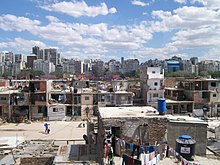
A Villa Miseria in Buenos Aires
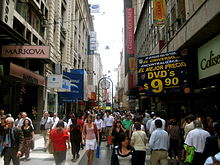
down Florida
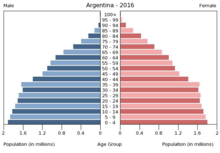
Argentina's population structure in 2016 (Source: CIA World Factbook)

Volga Germans settled primarily in the province of Entre Ríos.

Family in the north of Argentina
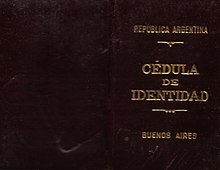
Cedula de Identidad - Argentina - Buenos Aires - 1934

Population development 1869 to 2015 (green: projection)

It is estimated that more than 25 million Argentines have at least one Italian ancestor. Italians are one of Argentina's largest immigrant groups.
Questions and Answers
Q: What is the official language of Argentina?
A: The official language of Argentina is Spanish.
Q: What other languages are spoken in Argentina?
A: In addition to Spanish, other languages spoken in Argentina include Italian, German, English, Quechua and Welsh.
Q: What is the capital city of Argentina?
A: The capital city of Argentina is Buenos Aires. It is located in eastern Argentina and it is one of the largest cities in the world.
Q: What are some of the largest cities in order by population size?
A: The largest cities in order by population size are Buenos Aires, Córdoba, Rosario, Mendoza, La Plata, Tucumán, Mar del Plata, Salta Santa Fe and Bahía Blanca.
Q: Where is Argentina located geographically?
A: Geographically speaking, Argentina lies between the Andes mountain range to its west and the southern Atlantic Ocean to its east and south. It also borders Paraguay and Bolivia to its north; Brazil and Uruguay to its northeast; Chile to its west and south; as well as claiming sovereignty over both Falkland Islands (Spanish Islas Malvinas) and South Georgia & South Sandwich Islands.
Q: Who makes up most of Argentine Republic's citizens? A: Most citizens of Argentine Republic are descendants from immigrants from Europe who have united under citizenship rather than ethnicity. Most Argentinians embrace both their ethnic origins as well as their Argentinian nationality.
Search within the encyclopedia